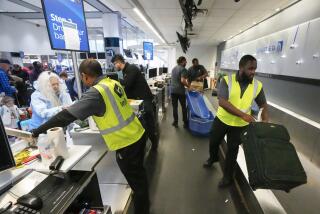Air Tickets’ Base Price Is Just Part of the Fare
- Share via
Have you looked at the corner of an airline ticket recently, where the fare, fees and taxes appear to be listed? I have, and most of it was indecipherable to me.
One thing I do know: A new fee soon will appear, a “security service fee” of up to $10 per round trip.
Congress authorized it in November to pay for aviation security improvements in the aftermath of the Sept. 11 attacks, and it is expected to begin next month.
So it seems like a good time to look at the taxes and fees that the federal government and the airports load onto our airline tickets to pay for airport building projects, FAA operations and more.
So much more.
“Ultimately it’s the passenger who pays for everything in this [aviation] system,” says Stephen Van Beek, senior vice president for policy at Airports Council International-North America.
Let’s start by deciphering the codes on a round-trip ticket that I priced Dec. 26 for travel Feb. 9 to 15 from LAX to Albuquerque, with a connection in Phoenix.
Here’s what it shows, followed by “translations” from the Federal Aviation Administration and other experts. (The order of these listings may vary according to the issuer and whether it’s a paper ticket or an e-ticket receipt, but the codes are generally the same.)
* USD 133.03: Base fare--the ticket price before taxes and fees.
* US 9.97: Domestic passenger ticket tax.
* XT 24.00: Total of domestic flight segment fees plus passenger facility charges.
* USD 167.00: Total ticket price including taxes and fees.
The fare listed in big type in airline advertisements is generally the total of the base fare (often only one way) and the domestic passenger ticket tax. Smaller type at the bottom lists the other taxes.
The new security service fee would bump this ticket’s price by $10, for a total of $43.97 worth of taxes and fees, the equivalent of 33% of the $133.03 base fare.
Did I mention that some passenger facility charges also may be increasing as a result of congressional action? (More on that later.)
And that’s just the breakdown on a domestic ticket.
“We think there are about 1,700 variations of 760 taxes that can go on an airline ticket around the world,” says Howard Goldberg, director of taxation and insurance for the International Air Transport Assn., or IATA, in Montreal.
He doesn’t know the exact number, he says, because “we get two or three new fees every day.”
IATA maintains a list of categories, by nation and territory, of taxes and fees on airline tickets, last updated in February. Among the more colorful entries: a “tourist development tax” (Benin, in Africa), “consumption tax” (Japan), “alien head tax” (Philippines) and my favorite, “Great Man-Made River Tax” (Libya).
Since Sept. 11, some airlines, mostly in less developed nations, have added “war risk surcharges” to pay for higher insurance premiums, Goldberg says.
Just be glad you don’t live in the Netherlands. As of February, the U.S. allowed seven types of taxes and fees on airline tickets (some only on international tickets). The Netherlands slapped on 11 kinds, including “security taxes” and “noise isolation charges,” the most taxes of any nation or territory on the IATA list.
Here is what U.S. taxes and fees are used for, according to the FAA:
* Domestic passenger ticket tax. This goes into the government’s Aviation Trust Fund, which finances FAA operations. Since 1997 this congressionally mandated tax has been reduced from 10% of the base fare (the ticket price before taxes) to 7.5%, where it is to remain until 2007, says FAA spokesman William Shumann.
* Domestic flight segment fee. (This may be coded separately on your ticket as ZP or be listed as “federal excise tax” in airline advertisements.) This tax, which was first imposed in 1997, also goes into the Aviation Trust Fund. But instead of falling like the domestic passenger ticket tax, it has been increasing.
At first it was $1 per “segment,” or leg, of the flight. (A round trip with one stopover each way has four segments; a nonstop round trip has two segments.) By 2001 it had increased to $2.75 per segment, and on Jan. 1 it went to $3.
From now on, increases are supposed to be linked to the Consumer Price Index, Shumann says.
* Passenger facility charge, or PFC. (This may be coded separately on your ticket as XF or be listed as “local airport charge” in airline ads.) This is imposed by U.S. airports, subject to approval by the FAA, and is collected on their behalf by airlines.
The FAA regulates how the money can be used, generally for infrastructure such as safety improvements or noise reduction.
The charge, first authorized in 1990, was capped at $3 per airport, generally assessed each time a passenger departs. In April the cap was increased to $4.50, and many airports wasted little time in reaching it.
By the end of October more than 90 had been approved for $4.50, according to the Airports Council International. (Some don’t actually begin charging that rate until this year.)
Expect more $4.50 charges to be approved soon, thanks to the Sept. 11 attacks.
The Aviation and Transportation Security Act passed by Congress in November calls on the FAA to expedite the airports’ applications for the charge to pay for added security.
You can find the per-airport PFC charge on your ticket, but it’s not obvious. In the example above, it appears at the end of a long block of letters and numbers as XFLAX3 PHX3ABQ3PHX3. The XF is the code for the tax, followed by the airport (also in code, i.e., LAX for Los Angeles International Airport, PHX for Phoenix, ABQ for Albuquerque) and the amount (in this case, $3 at each airport).
* Security service fee. This new fee, part of November’s Aviation and Transportation Security Act, will start appearing Feb. 1 on airline tickets, according to the DOT. The fee is $2.50 per segment, with a maximum of $5 allowed one way or $10 round trip. It goes to the newly created Transportation Security Administration within the Department of Transportation to finance airport security.
This year airline passengers can expect other costs to increase too. One problem, experts say, is that airlines lost billions after Sept. 11 and, on top of that, are implementing costly new security measures. The travel slump and increased security expenses also cost U.S. airports $3 billion to $4 billion after Sept. 11, Van Beek of the Airports Council International estimates.
“We’re in a big hole,” he says, predicting that numerous airports will try to raise various fees. One option is to increase landing fees, which airports charge airlines. Because they increase the cost of doing business, such charges are often passed on to the consumer.
In December, Los Angeles airport commissioners considered, then put on hold, a proposal to raise parking fees in LAX’s central terminal from $24 to $35 a day.
Jane Engle welcomes comments and suggestions but cannot respond individually to letters and calls. Write Travel Insider, Los Angeles Times, 202 W. 1st St., Los Angeles, CA 90012, or e-mail jane [email protected].
More to Read
Sign up for The Wild
We’ll help you find the best places to hike, bike and run, as well as the perfect silent spots for meditation and yoga.
You may occasionally receive promotional content from the Los Angeles Times.






